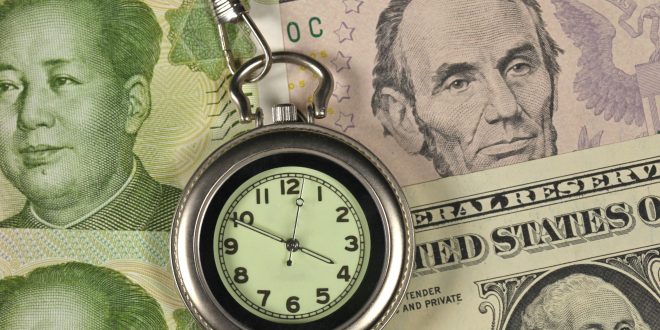The weaker US dollar and risk aversion were in news headlines most of the time during Friday’s US trading session. The positive employment report on the United States suggested the Fed might need to keep hiking rates to ease a contracted labour market, though it failed to reinforce the US dollar.
The Dollar
The US dollar slid on Friday despite the strong US jobs report and retreated to test the 104.50 territory. Although the NFP data showed that stronger-than-expected hiring reflected how the labour market is still tight, investors are generally distressed regarding the US dollar because Fed officials spoke dovish on the outlook during last week. The jobs data should help to stem some of the USD’s retreating, but reversal seems unlikely in the following sessions. The dollar got sandwiched between support and resistance following the data.
Following a strong move by the US dollar bulls, Chicago Fed President Charles Evans made dovish comments that put an end to the USD’s rally. Evans said that the pace of increases is likely to slow and added that the Fed could need to raise borrowing costs to a “slightly higher” peak than envisioned in forecasts from September.
A softening of the Federal Reserve’s primary inflation measure, the Core Personal Consumption Expenditure (PCE) to 0.2% from 0.5% in November weighed on the dollar as well.
Crude Oil
Russia accused the West of violating the rules of the World Trade Organization. Russia also announced that it would not export oil under the price cap recently set by EU nations despite potentially needing to cut its oil production. Russia will continue to sell oil to countries that follow the free market rules and is working on measures to impose ban on oil exports to the countries that intend to follow the West’s price cap.
On Friday, EU member states, the US, the UK, Canada and Australia agreed to set the price of Russian oil exports at USD 60 per barrel as from this Monday.
Oil prices fell on early Friday after the dollar recovered some of its losses, while the easing of anti-COVID-19 restrictions in two Chinese cities limited losses. Brent crude futures fell 11 cents, or 0.1 percent, to $86.77 a barrel, while West Texas Intermediate crude futures fell 14 cents, or 0.2 percent, to $81.08 a barrel.
The dollar rose after falling to a 16-week low against a basket of major currencies after data revealed that consumer spending in the United States increased strongly in October.
The two benchmarks are still in the process of recording their first weekly gains after three consecutive weeks of declines, with two Chinese cities easing anti-Covid-19 restrictions. On Wednesday, Guangzhou and Chongqing announced the easing of anti-epidemic restrictions.
European Stocks
European stocks held gains for the seventh week in a row amid easing fears of tightening monetary policy globally. However, stocks fell on Friday ahead of the release of US jobs data. The pan-European Stoxx 600 index fell 0.5 percent after two days of strong gains. Investors are awaiting US jobs data, which will influence the Federal Reserve’s plans to raise interest rates in the future.
The Stoxx 600 index is heading for weekly gains, recording an increase of about 0.3 percent, in the longest series of gains since April 2021, as optimism also stemmed from China’s easing of its position regarding the strict restrictions imposed to combat Covid, which had harmed global growth.
Gold
The precious metal closed the week in positive territory despite Friday’s pullback. XAU/USD eyes a break above $1,800 as preserves its bullish bias, the precious metal closed at $1802 per ounce.
Wall Street
Wall Street is rejoicing on the latest comments by Jerome Powell. The S&P 500 has gained the first day in four following significantly dovish comments by Fed’s Jerome Powell confirming that the US Fed will slow the pace of its hawkish rate-hiking that impacted financial and exchange markets.
The broad index added 1% following Powell’s comments. The Dow Jones Industrial Average was up 157 points, or 0.5%. Meanwhile, the tech-heavy Nasdaq Composite jumped 1.1%.
“It makes sense to moderate the pace of our rate increases as we approach the level of restraint that will be sufficient to bring inflation down,” Powell said in a speech at the Brookings Institution, adding that “the time for moderating the pace of rate increases may come as soon as the December meeting.”
But overall stock gains were muted as Powell also warned that Fed could maintain its previously adopted restrictive policy for a long time before it ends its endeavours and measures that are meant to combat inflation.
“Despite some promising developments, we have a long way to go in restoring price stability,” Powell said.
Powell’s comments cemented optimism among investors and traders that the US central bank will decide on a smaller 0.5 percentage point rate hike at its next meeting after the previous four successive 0.75 percentage point hikes to tame hot inflation. Any signal of a slower-paced tightening is sufficient reason why markets can edge higher.
 Noor Trends News, Technical Analysis, Educational Tools and Recommendations
Noor Trends News, Technical Analysis, Educational Tools and Recommendations





